Articles
- Page Path
- HOME > J Korean Powder Metall Inst > Volume 24(5); 2017 > Article
-
ARTICLE
다양한 크기의 솔더 파우더를 이용한 솔더 페이스트의 저장안정성 향상에 관한 연구 - 임찬규, 권보석, 손민정a, 김인영a, 양상선b, 남수용*
- A Study on the Improvement of Storage Stability of Solder Paste Using Multiple size of solder Powder
- Chan-Kyu Lim, Bo-Suk Gyun, Min-Jung Sona, Inyoung Kima, Sangsun Yangb, Su-Yong Nam*
-
Journal of Korean Powder Metallurgy Institute 2017;24(5):395-399.
DOI: https://doi.org/10.4150/KPMI.2017.24.5.395
Published online: September 30, 2017
부경대학교 인쇄공학과
한국기계연구원
b 한국기계연구원 부설 재료연구소 분말/세라믹 연구본부
Pukyong National University, 365 Sinseon-ro, Nam-gu, busan 48513, Republic of Korea
a Korea Institute of Machinery and Materials, 156 Gajeongbuk-ro, Yuseong-gu, dejeon 34103, Republic of Korea
b Korea Institute of Materials Science, 797 changwondae-ro, Seongsan-gu, changwon 51508, Republic of Korea
- *Corresponding Author: Chan-Kyu Lim, +82-51-624-8179, +82-51-629-6388, elffpdl123@nate.com
• Received: September 15, 2017 • Revised: October 10, 2017 • Accepted: October 12, 2017
© The Korean Powder Metallurgy Institute. All rights reserved.
- 1,057 Views
- 8 Download
Abstract
- Solder paste is widely used as a conductive adhesive in the electronics industry. In this paper, nano and microsized mixed lead-free solder powder (Sn-Ag-Cu) is used to manufacture solder paste. The purpose of this paper is to improve the storage stability using different types of solvents that are used in fabricating the solder paste. If a solvent of sole acetate is used, the nano sized solder powder and organic acid react and form a Sn-Ag-Cu malonate. These formed malonates create fatty acid soaps. The fatty acid soaps absorb the solvents and while the viscosity of the solder paste rises, the storage stability and reliability decrease. When ethylene glycol, a dihydric alcohol, is used the fatty acid soaps and ethylene glycol react, preventing the further creation of the fatty acid soaps. The prevention of gelation results in an improvement in the solder paste storage ability.
- 전자산업이 발전함에 따라 소형화 고집적화 된 전자부품 이 설계, 생산되고 있다. 인쇄공정은 대량생산 및 단가 절감 등의 이유로 MLCC(Multi Layer Ceramic Condencer), RFID (Radio Frequency Identification), 패키징, 태양전지 등 다양 한 분야에 적용되고 있다. 그 중 패키징 분야에서 솔더페이 스트를 인쇄에 적용한 접합기술에 관한 연구가 활발히 연 구 중이다[1]. 솔더페이스트는 solder powder, flux, resin, solvent등으로 구성되어 있고 flux는 activator, solvent, resin, a Thixo agent등을 포함한다.
- Solder powder는 최근까지 주로 SnPb가 사용되어 왔다. SnPb는 저융점, 우수한 젖음성 및 기계적 특성과 낮은 가 격으로 저온 joining 합금으로 많이 사용되어왔다[2, 11]. 하지만 유럽연합(EU)에서는 SnPb 합금의 사용을 규제함 으로써 SnPb 합금의 대체품을 찾았고[2, 3] 그 대체 물질 로써 Sn-Ag-Cu합금이 주목받고 있다[2, 3].
- Sn-Ag-Cu합금은 현재까지 연구된 다른 solder powder들 과 비교해서 젖음성, 솔더링 특성, 고강도, 신뢰성, 연성 등에서 우수한 특성을 지니고 있어[3-5, 12] 패키징 분야 에서 주로 연구되고 있다.
- Sn-Ag-Cu합금을 이용하여 제조된 솔더페이스트의 경우, nano 크기의 solder powder를 혼합할 때 솔더페이스트의 탄성 증가로 인해 solder bump의 소형화, 고집적화를 실현 할 수 있을 뿐만 아니라 solder alloy/joint의 특성을 개선 할 수 있다[13, 16, 17].
- 하지만 nano 크기의 solder powder는 산화, 확산, 그리고 금속간의 화합물 형성 등의 문제점이 아직 남아있다[14]. 그리고 솔더페이스트를 구성하는 재료 중 activator로 사용 되는 acid는 nano 크기의 solder powder를 활성화 시켜주 는 반면에 nano 크기의 solder powder의 산화층과 반응하 여 솔더페이스트의 점도를 변화시킨다. 이러한 점도변화 는 솔더페이스트의 젖음성을 감소시키고 그 결과 PCB와 전자 부품사이의 joint불량을 야기 시킬 수 있다. 지금까지 언급했던 문제점들은 솔더페이스트의 저장안정성, 신뢰성 등에 영향을 주어 솔더페이스트의 보관기간을 감소시키고 생산라인에서 갑작스런 joint 불량을 야기해 공정상에 문 제를 일으킬 수 있다.
- 이러한 문제점을 해결하기 위해 이 연구는 solder bump 의 소형화, 고집적화를 위해 nano, micro 크기의 Sn-Ag- Cu solder powder를 혼합하여 솔더페이스트를 제조했고 그 결과 발생한 저장안정성, 신뢰성 등의 문제를 해결하기 위해 솔더페이스트의 제조 시 사용되는 solvent의 종류에 따른 저장안정성 개선을 목표로 하였고, FT-IR(Fourier transform infrared), Viscometer, ICP(Inductively Coupled Plasma) 분석을 통해 저장안정성을 평가하였다.
서 론
- 2.1. Materials
- 실험에 사용된 nano 크기의 solder powder는 그림 1에 나타내었고 한국재료연구소에서 그리고 micro 크기의 solder powder는 덕산하이메탈에서 공급받았다. 각각 D50=100 nm, D50=2 μm의 크기의 Sn-Ag-Cu 합금이며 조 성은 Sn3.0Ag0.5Cu이다.
- Flux(ALPHA CVP-390, Alpha Co. U.S.A) 및 resin은 (STD10, The Dow Chemical, U.S.A)을 사용하였고 solvent는 acetate계열과 에틸렌글리콜(ethylene glycol)을 사용하였다. 마지막으로 nano 크기의 solder powder에 존재하는 산화피 막을 벗겨주기 위한 activator 역할의 유기산으로는 malonic acid가 첨가되었다.
- 2.2. Fabrication of solder paste
- Powder형태의 에틸셀룰로오스 Resin과 acetate계열의 solvent를 20:80 wt%로 혼합한 후 60°C에서 용해하여 binder를 제조하였다. 그리고 malonic acid는 solvent에 40:60wt%로 혼합한 후 80°C에서 용해하여 제조하였고 이 러한 방법으로 제조된 binder 및 유기산 용해물을 이용하 여 솔더페이스트를 제조하였다. 그림 2는 솔더페이스트의 제조를 나타낸 모식도이고 솔더페이스트의 제조 순서는 먼저 binder, flux, solvent, additive 그리고 solvent에 용해 시킨 Malonic acid를 혼합하여 pre-mixing을 진행한 후 교 반&탈포 공정을 진행한다. 그리고 micro 크기의 solder powder를 혼합하고 pre-mixing, 교반&탈포 공정을 실시한 다음 nano 크기의 solder powder를 혼합하고 pre-mixing, 교반&탈포 공정을 마친 후에 3-roll-mill 공정을 통해 솔더 페이스트를 분산시켜준다.
- 2.3. Measurement
- 솔더페이스트의 유변학적 성질을 분석하기 위해 그림 3 에 나타낸 전단점도계(Rheoscope 1, HAAKE, Germany)를 사용하여 솔더페이스트의 유변물성을 측정하였다. 측정 항목은 0.1~100 범위의 전단속도에 따른 점도 변화를 측 정하였다. 시료대는 직경이 35 mm의 평행판이고 시료대 와 센서 사이의 간격은 0.8 mm로 설정하였으며, 이때 측 정온도는 23°C로 하였다[8].
- Nano 크기의 solder powder와 malonic acid가 반응을 하 여 생성되는 지방산염 성분확인을 위해 유도결합 플라즈 마 ICP(Inductively Coupled Plasma)을 측정하였다. 유도결 합 플라즈마는 질량 분석기의 일종으로 이하의 작은 함량 을 지니는 금속과 몇 가지 비금속 원소의 농도를 측정하 는데 이용할 수 있다[9].
- 유도 결합 플라즈마를 이용하여 시료를 이온화 시키고, 해당 이온들을 질량 분석기를 이용하여 분리하여 측정을 하였다. 온도는 23°C, 상대습도는 32%인 시험환경에서 측 정을 하였다.
- FT-IR(Fourier transform infrared) 분석을 통해 nano powder 가 솔더페이스트에 혼합되는 유무에 따라 어떤 peak의 차가 발생하는지 분석하기 위해 사용했다. FT-IR은 간섭계를 사 용하여 위상 변조한 적외선 영역의 백색광을 사용하는 적 외선 분광학의 한 종류로서, 시료에 적외선을 비추어서 쌍 극자 모멘트가 변화하는 분자 골격의 진동과 회전에 대응 하는 에너지의 흡수를 측정하는 분석법을 말한다[10].
실험 방법
Fig. 2
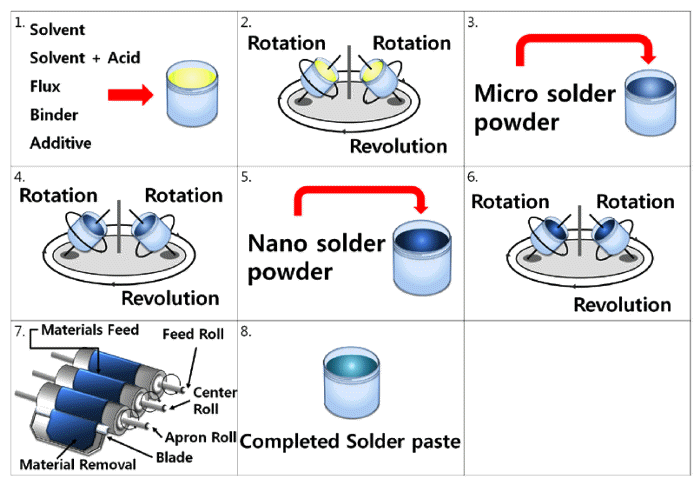
Fabrication process of solder paste. : 1. Mixed binder, flux, additive, solvent and Malonic acid dissolved in solvent 2. mixing and antifoaming process step 3. mirco solder powder mixing step 4. mixing and antifoaming process step 5. nano solder powder mixing step 6. mixing and antifoaming process step 7. Dispersion step by 3-roll-mill, 8.Completed solder paste.

- Sn-Ag-Cu 솔더페이스트의 저장안정성이 문제가 되는 근 본적인 이유는 그림 4에 그림으로 나타내었는데 Sn-Ag-Cu 로 구성이 되어있는 nano 크기의 solder powder에 malonic acid를 첨가하게 될 경우 malonic acid가 nano solder powder 의 산화부와 반응하게 된다. 이때, Sn-Ag-Cu malonate를 형 성하게 되고, 형성된 malonate들은 지방산염들을 생성시킨 다. 이때 지방산염들은 주위의 solvent를 흡수하여 솔더페이 스트의 점도를 상승하게 됨으로써 저장안정성의 문제가 발 생한다[11].
- 먼저 solvent, resin 및 additive는 동일한 조건하에 솔더 페이스트에서 nano 크기의 powder 혼합 유무에 따른 FTIR spectra를 비교, 분석하였다.
- 그림 5는 FT-IR분석에 따른 결과이며 nano powder가 첨 가된 paste A는 1680-1740 cm-1파장에서 peak가 나타남을 알 수 있었다. 이 파장영역은 carboxyl group을 뜻하게 되 는데, nano 크기의 powder은 표면에 산화피막을 형성하게 되고 이 산화피막이 유기산과 반응하여 carboxyl group를 형성함을 알 수 있었다. paste B는 Gel화가 진행되지 않았 지만 paste A는 Gel화가 진행되었다. 즉 paste A의 nano 크기의 solder powder가 acid와 반응에 의해 생성된 carboxyl group이 Gel화를 야기 시켰음을 알 수 있었다.
- 1680-1740 cm-1 파장의 peak가 carboxyl group임을 확인하기 위해서 carboxyl group을 포함한 BCA(2-(2-Butoxyethoxy) ethyl acetate) ECA(2-(2Ethoxyethoxy)ethyl acetate), MEK (methyl ethyl Ketone, 2-butanone), Acetone 등 4종의 solvent로 FT-IR측정을 실시했다. 그림 6과 같이 1680-1740 cm-1 파장에 서 peak가 발생함을 확인하였다.
- Solder bump의 형성에 문제가 되지 않고 nano 크기의 powder와 유기산이 반응물인 지방산염의 문제를 해결하기 위한 방법으로 solvent의 종류에 초점을 맞추어 솔더페이 스트를 제조하여 특성을 평가하였다.
- 지방산염의 형성을 최대한 막기 위해서 에틸렌글리콜 (ethylene glycol)을 첨가하였다. 에틸렌글리콜(ethylene glycol)은 C2H4(OH)2로 2가 알코올 이므로 지방산염과 반 응하게 되어 생성되는 지방산염의 양을 감소시킴으로써 Gel화를 방지할 수 있다.
- ICP 측정의 단위는 mg/Kg이고 M.D.L 은 Method detection limit를 뜻한다. 표 1에 ICP측정에 관한 결과를 나타내었다. P1은 micro 및 nano 크기의 solder powder와 기존의 acetate 계열의 solvent를 첨가하여 paste를 제조하 였고, P2는 micro 크기의 Solder powder를 단독으로 사용 하고 acetate 계열의 solvent를 첨가하여 paste를 제조하였 다. P3는 micro 및 nano 크기의 solder powder와 기존의 acetate 계열의 solvent가 아닌 에틸렌글리콜(ethylene glycol)을 첨가하여 paste를 제조하였다.
- 시험항목에서 Sn의 수치가 높을수록 지방산염의 생성이 감소함을 알 수 있다. P1은 1.1 mg/Kg으로써 수치가 낮아 지방산염이 생성되어 Gel화가 일어남을 알 수 있었고, P2 는 8.3 mg/Kg로 수치가 매우 높고 Gel화가 일어나지 않음 을 알 수 있었다. P3는 3.5 mg/Kg의 수치를 나타내었으며 수치가 1.1 mg/Kg인 P1과 비교하였을 때 Sn 지방산염의 수치가 낮음으로 Gel화 방지에 유리하다고 분석하였다.
- 솔더페이스트의 점도변화율을 전단점도계로 검토한 결 과 그림 7과 같은 결과를 나타내었다.
- P1과 P3는 유사한 형태의 점도 변화율을 보였으며 P1은 2일차까지 급격한 점도 증가를 보였으나 후에 안정적인 변 화율을 보였고 최고 24.6%까지 변화함을 알 수 있었다. P3 도 2일차까지 점도의 증가를 보였으나 10.5%로 P1보다 안정적인 점도 변화를 나타냄을 알 수 있었다. 그리고 nano powder가 첨가되지 않은 paste B가 가장 안정적인 점도 변화를 보였다.
실험결과 및 고찰
Fig. 5
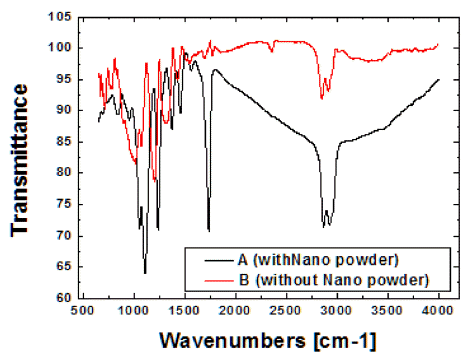
FT-IR spectra of solder paste : Without nano powder (Black line, A) and with nano powder (Red line, B).

Fig. 7
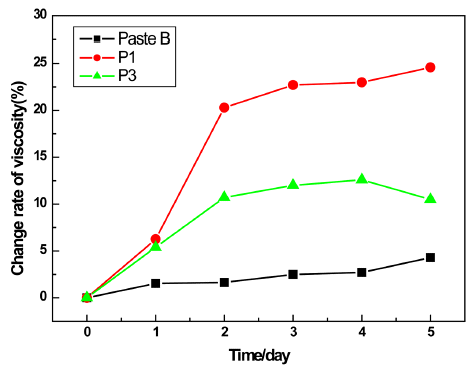
Change rate of Pastes viscosity with time : Paste B Without nano powder, P1 using an acetate based solvent and P3 using an Ethylene glycol.

- 솔더페이스트에 사용되는 solvent의 종류에 따라 서로 다 른 크기의 nano, micro powder를 사용하여 제조된 솔더페이 스트의 저장안정성을 평가한 결과 nano Solder powder와 acid를 혼합하게 될 경우 acid가 nano Solder powder의 산화 피막을 벗겨내고 malonate를 형성하게 된다. 형성된 malonate들은 지방산염들을 생성시키고 지방산염들은 주 위의 solvent를 흡수하게 되어 Gel화를 촉진시키게 됨을 알 수 있었다. 그에 따른 해결방안으로는 기존에 사용하던 acetate계열의 solvent를 단독으로 사용하는 것 보다 2가 알코올인 에틸렌글리콜(ethylene glycol)을 사용하여 지방 산염과 반응시켜 Gel화를 방지할 수 있었다.
결 론
- 1. J. Osenbach, A. Amin, M. Bachman, F. Baiocchi, D. Bitting, D. Crouthamel, J. DeLucca, D. Gerlach, J. Goodell, C. Peridier, M. Stahley and R. Weachock: J. Electron. Mater.., (2009) 38 303.ArticlePDF
- 2. R.A. Islam, B.Y. Wu, M.O. Alam, Y.C. Cahn and W. Jilek: J. Alloys Compd.., (2005) 392 149.Article
- 3. R. Durairaj, S. Ramesh, S. Mallik, A. Seman and N. Ekere: Mater. Des.., (2009) 30 3812.Article
- 4. K.N. Tu and K. Zeng: Mater. Sci. Eng. Rep.., (2001) 34 1.Article
- 5. I.E. Anderson: J. Mater. Sci. Mater. Electron.., (2006) 18 55.ArticlePDF
- 6. J. Shen and Y.C. Chan: Microelectron. Reliab.., (2009) 49 223.Article
- 7. L. Ye, Z. Lai, J. Liu and A. Tholen: IEEE Trans. Compon. Packag. Manuf. Technol.., (1999) 22 299.
- 8. C.W. Macosko and R.G. Larson, In : Knovel, editor. Rheology: Principles, Measurements, and Applications, (1994) VCH, New York.
- 9. T.E. Standaert, M. Schaepkens, N.R. Rueger, P.G. Sebel and G.S. Oehrleinc: J. Vac. Sci. Technol.., (1998) 16 239.ArticlePDF
- 10. P.R. Griffiths and J.A. De Haseth, In : D. James, Winefordner, editors. Fourier Transform Infrared Spectrometry(2007) 2nd edJohn Wiley & Sons, Hoboken.
- 11. K. Masashi, T. Takahashi, A. Kano and T. Sato: ICEPIACC., (2015) 106 314.
- 12. S.M. Nai, J.V. Kuma, M.E. Alam, X.L. Zhong, P. Babaghorbani and M. Gupta: J. Mater. Eng. Perform.., (2010) 19 335.ArticlePDF
- 13. L.Y. Hsiao and J.G. Duh: J. Electron. Mater.., (2006) 35 1755.ArticlePDF
- 14. A.S. Haseeb, M.M. Arafat and M.R. Johan: Mater. Charact.., (2012) 64 27.Article
- 15. Z. Gu, H. Ye, D. Smirnova, D. Small and D.H. Gracias: Small., (2006) 2 225.Article
- 16. K. Mohankumar and A.A. Tay, Electronics Packaging Technology Conference 2004, EPTC2004, proceedings of 6th. (2004.
- 17. M. J. Son, I. Y. Kim, S. S. Yang, T. M. Lee and H. J. Lee: Microelectron. Eng., (2016) 164 128.Article
Figure & Data
References
Citations
Citations to this article as recorded by 

A Study on the Improvement of Storage Stability of Solder Paste Using Multiple size of solder Powder


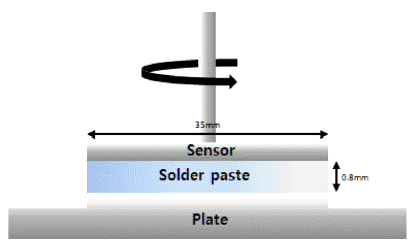
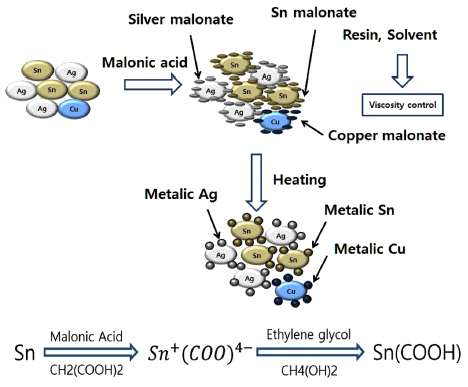



Fig. 1
The TEM images of Solder powders.: 1. Nano D50= 100 nm, 2. micro, D50=2 μm.
Fig. 2
Fabrication process of solder paste. : 1. Mixed binder, flux, additive, solvent and Malonic acid dissolved in solvent 2. mixing and antifoaming process step 3. mirco solder powder mixing step 4. mixing and antifoaming process step 5. nano solder powder mixing step 6. mixing and antifoaming process step 7. Dispersion step by 3-roll-mill, 8.Completed solder paste.
Fig. 3
Parallel plate of Rheometer.
Fig. 4
Mechanism of fatty acid formation.
Fig. 5
FT-IR spectra of solder paste : Without nano powder (Black line, A) and with nano powder (Red line, B).
Fig. 6
FT-IR spectra of Solvent containing carboxyl group.
Fig. 7
Change rate of Pastes viscosity with time : Paste B Without nano powder, P1 using an acetate based solvent and P3 using an Ethylene glycol.
Fig. 1
Fig. 2
Fig. 3
Fig. 4
Fig. 5
Fig. 6
Fig. 7
A Study on the Improvement of Storage Stability of Solder Paste Using Multiple size of solder Powder
| 시료명 | 단위 | 시험항목 |
|---|---|---|
|
|
||
| Sn | ||
|
|
||
| P1 | ppm | 1.1 |
| P2 | ppm | 8.3 |
| P3 | ppm | 3.5 |
| M.D.L | Ppm | 2.0 |
Table 1
The ICP data of solder pastes
Table 1
TOP
 KPMI
KPMI

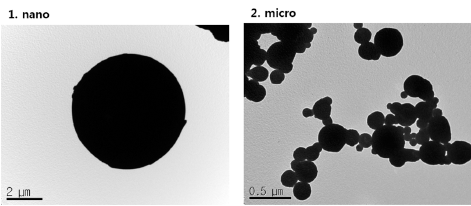


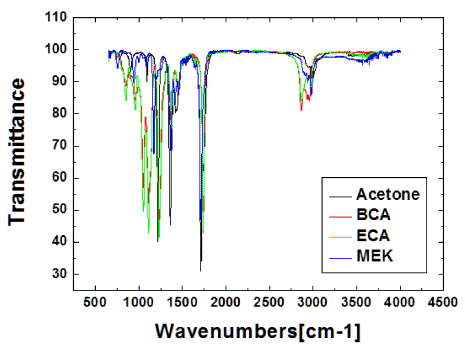
 Cite this Article
Cite this Article







